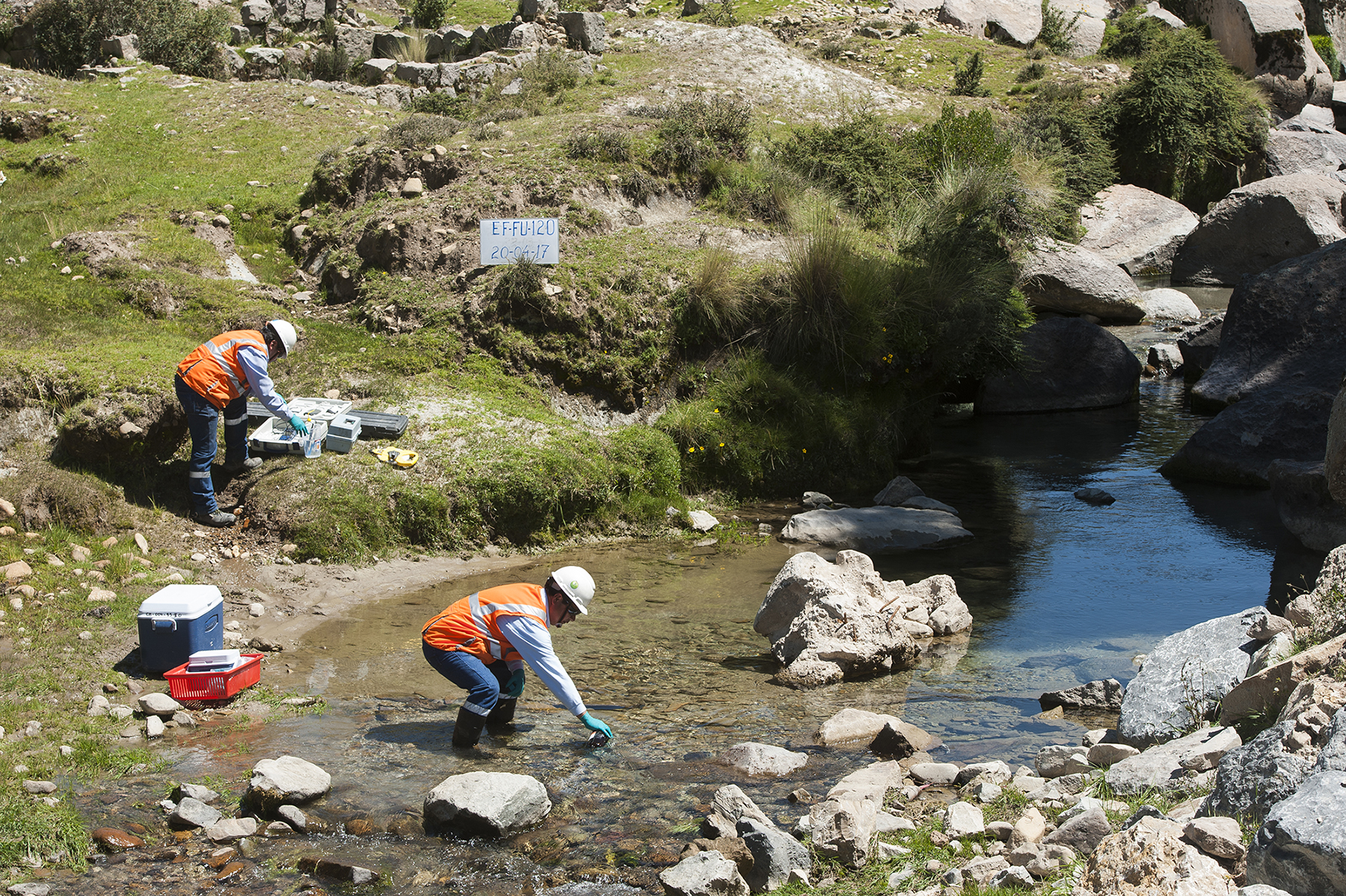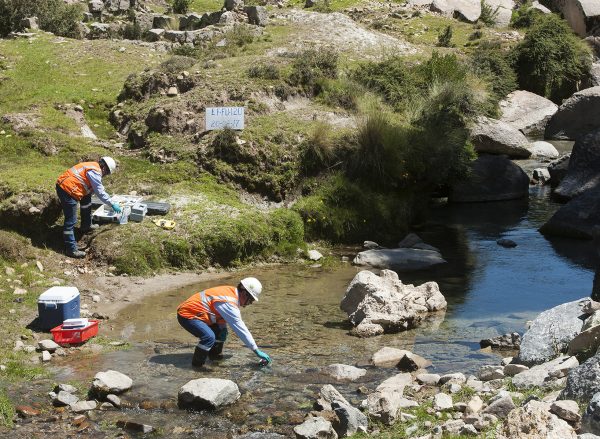MMG is committed to minimising our environmental footprint and use of natural resources. As a member of the International Council on Mining and Metals (ICMM), we are committed to align to their 10 sustainable development principles, which are articulated in our company policies and standards.
Our approach to environmental management involves identifying and controlling potential environmental impacts across all phases of our business from exploration through to development, operation and closure, with ongoing review of control effectiveness.
Las Bambas is required to follow MMG’s policies and standards for environmental management and monitoring, as well as all Peruvian legislation around environmental protections. It is also fully compliant with its Environmental and Social Impact Assessment (ESIA), and proactively engages with Peruvian regulators on its environmental monitoring results and opportunities for improvement.
Water Management
At MMG we use water in both our mining and ore extraction processes and therefore need to secure water for the efficient and consistent performance of our operations. We regularly monitor and actively manage the quantity and quality of the water we use and release. We are particularly mindful about using water resources that are required for maintenance of environmental ecosystems and are shared with by surrounding communities.
In supporting the ICMM Position Statement on Water, we commit to support water stewardship initiatives that promote better water use, effective catchment management and contribute to improved water security and sanitation. We have a company-wide objective to effectively manage our water intake, inventory and release to minimise our impacts on other users within the catchment including upstream and downstream communities and the environment. Targets tailored to site specific requirements and risks are set against these objectives.
We have established clear accountabilities for regularly reviewing and updating our water balance models and measuring the effectiveness of our critical water management controls.
We report our water inputs, outputs and diversions in line with the ICMM Water Accounting Framework. This includes monthly reporting to national water authorities, in-line with each operation’s ESIA.
At Las Bambas, in 2018, there was a 24% reduction in water taken from run-off and a 71% reduction of water taken from rivers and creeks. This is due to increased reuse efficiency and improvements in site water management processes, as well as the freshwater pipeline installed in late 2017 coming online. Detailed information about water use can be found on page 59 of Las Bambas’ 2018 Sustainability Report.
The water management infrastructure at Las Bambas was designed to take advantage of seasonal surface water availability, including the consideration of both environmental flows and downstream water requirements.
Las Bambas uses multiple storage facilities to collect rainfall and run-off and to maximise water use and recycling. This eliminates discharge of any contact water to the environment and minimises the need to extract water from external water sources, such as the Challhuahuacho River, to meet operational requirements.
Over the last year, the team at Las Bambas have further refined their systems for minimising environmental and community impacts through the seasons against site operational water requirements. A daily water status report is produced to enable the Las Bambas team to continually adjust plant operating processes to obtain optimal water balance management. This more detailed understanding has also contributed to better forecasting in relation to medium and longer-term requirements.
As part of its regulatory legal compliance, Las Bambas reports its water management on a regular basis. Every month, a report on water inputs is submitted to the Peruvian environmental ministry, and every three months a report on water outputs is submitted.
In 2018 Las Bambas was able to source most of their processing water requirements from the tailings storage facility (TSF) or directly from the tailings stream, with supplemental water predominately sourced from the on-site Chuspiri freshwater dam.
These changes have meant that Las Bambas has been able to significantly reduce the consumption of water from local rivers and minimise operational water volumes within the site TSF.
We have ongoing programs to find opportunities for improvements in catchment management at all our operations. MMG has committed to a major water infrastructure program focused on the diversion of clean catchment run-off around the operational mining areas at Las Bambas. This program will greatly assist us to efficiently manage our site discharge requirements. This work will also assist in the preservation of the natural catchment flow regime which maintains downstream ecosystem health.
Air Quality Management
The bulk of our emissions to air are generated by blasting, heavy mobile equipment used for mining, product transport, primary crushing and onsite power generation.
We strive to be as efficient as possible in our combustion of fuel to manage costs and preserve a healthy working environment for our workers. We consider environmental and health implications in our supply contracts for equipment, electricity and fuel via our procurement processes. Information about our emissions can be found on page 64 of Las Bambas’ 2018 Sustainability Report.
We continuously improve our management of the impacts from dust generated by our activities. At Las Bambas, this includes watering heavy haul roads to keep dust to a minimum for surrounding communities and supporting the Government in the progressive sealing of roads. To date we have invested more than S/820 million in improving the public road between Las Bambas and the Pillones rail transfer facility in Arequipa.
Case study: Participatory environmental monitoring at Las Bambas
Our Las Bambas operation regularly conducts transparent participatory air, water and other environmental monitoring with local government, leaders and representatives from the communities in its area of influence, as well as independent monitoring experts in charge of off-site sample testing. This has helped us to strengthen understanding around the controls in place and compliance with our regulatory requirements in Peru.
The Participatory Environmental Monitoring program (MAP for its Spanish title –Monitoreo Ambiental Participativo) involves Las Bambas inviting local community leaders and representatives from communities to participate in environmental sampling processes. ALS CORPLAB, a Peruvian government-accredited company that undertakes the monitoring, and Las Bambas representatives explain the process and answer questions from the community representatives before sending the samples to Arequipa and Lima for independent testing.
When the results are finalised, workshops are held with the same community leaders and representatives to give the communities the opportunity to review the results and understand the crucial role environmental monitoring plays in achieving good outcomes for the community and the environment.
To date in 2019 the MAP has undertaken 24 different sampling processes, including water, air, noise, soil and native animal species, which involved a total of 176 participants.
| 2019 Participatory Environmental Monitoring program (MAP) | |
| Number of MAP | 24 |
| Number of participants | 176 total Men 43% Women 57% |
| Environmental components monitored | Water – Air – Noise – Soil – native animals |
Las Bambas also conducts regular site tours with local community members, taking them to the clarification pond, the open-pit lookout, the concentrate plant and the Chuspiri freshwater dam. Participants were also given the chance to hear from engineers and operators about the mine process, environmental monitoring on site and the proactive role Las Bambas takes with environmental management. 246 participants visited the operation over 13 visits; 47% women and 53% men.
Noise And Vibration
In line with our ESIA commitments locally, we identify the major sources of noise and vibration related to our activities and assess their potential impacts on the environment and local communities through monitoring and engagement processes. This informs the design and implementation of critical control plans to reduce identified risks.
At Las Bambas, our principal sources of noise are located within the footprint of the operation, at a significant distance from nearby communities. Despite this, we still engage with local communities on a regular basis through the MAP program and the grievance mechanism to ensure we capture any concerns and put plans in place to mitigate any identified issues.





